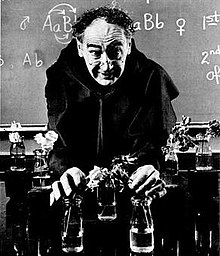Richard M. Eakin | |
|---|---|
 Eakin as Gregor Mendel, demonstrating genetic inheritance in pea plants circa 1974 | |
| Born | Richard Marshall Eakin May 5, 1910 |
| Died | November 25, 1999 (aged 89) |
| Nationality | American |
| Alma mater | UC Berkeley |
| Known for | Impersonating famous scientists, Parietal eye research |
| Spouses | Mary Mulford (1935–1980; 3 children) Barbara Nichols (?–1999) |
| Awards | Guggenheim Fellowship (1953) |
| Scientific career | |
| Fields | Zoology, Embryology |
| Institutions | UC Berkeley |
| Doctoral advisor | J. Franklin Daniel |
Richard Marshall Eakin (/ˈeɪkɪn/ AY-kin; May 5, 1910 – November 25, 1999), was an American zoologist and professor at the University of California, Berkeley. He was widely known for portraying prominent historical scientists during some of his lectures; dressing in costume and speaking in character to entertain and inform his students. A 1953 Guggenheim fellow, he wrote several books and more than 200 scientific papers. His research focused on eyes and vision in animals, especially the parietal eye or "third eye" of vertebrates, as well as animal embryology. He served as chairman of the UC Berkeley Department of Zoology for over 10 years, was elected president of the Western Society of Naturalists and American Society of Zoologists, and was a fellow of the California Academy of Sciences.
Eakin was born in Florence, Colorado, and grew up in Tulsa, Oklahoma. He initially studied at the University of Tulsa, planning a career in the clergy, before switching to zoology, earning a bachelor's degree and doctorate at UC Berkeley. After postdoctoral studies in Germany under Hans Spemann he returned to UC Berkeley as a faculty member, where he would teach for over 40 years, earning awards and recognition for his teaching before retiring with highest faculty honors.
